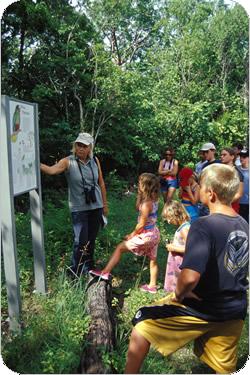Cayman Brac and Little Cayman Birds
Bird Specialist
If the question is about bird life in the Cayman Islands, the answer is to consult Patricia Bradley. A lifelong island resident and birdwatcher, Mrs. Bradley literally wrote the book on the subject - Birds of the Cayman Islands, to be precise. Better yet, her learning is available to you right here at this special area of naturecayman.com, offering her unique insight to enhance your knowledge and enjoyment of our islands' resident and migrant birds. . .

|
Patricia Bradley's Bird's-eye View
A special delight on the Brac is to reach the bluff forest trails in the cool and silent predawn, just
in time to hear the first parrot wakeup calls, followed, as the sun rises, by a wonderful dawn chorus.
The Brac parrot, the smallest green amazon in both size and population in the region, is best seen at
the protected National Trust Parrot Reserve at the Bight Road for much of the year. In summer, look along central Major Donald
Drive or listen for calls in mango trees at Stake Bay on the north coast.
Summer in these same locations is also your best choice for getting to know our very tame endemic
landbirds, such as the pretty vitelline warbler and the noisy red-legged thrush (also excellent for
migrants from September to early May). As they make their first forays for food, the birds are much too
preoccupied to pay attention to human visitors.
|
Conservation on Little Cayman, One of the regions most important birding area
Booby Pond Reserve on Little Cayman is a RAMSAR site (designated a wetland of international importance), owned and protected by the National Trust. Its 260 acres comprise the pond, mangrove fringe and the entire red- footed booby nesting areas in the dry forest and shrubland the north of the pond, and an additional buffer zone. The Reserve protects the largest colony of red-footed booby (5000 pairs) in the Caribbean, exceeding the 5% population level that qualifies it as an internationally recognized Important Bird Area (IBA). A mixed species heronry breeds in the forest as well as near-threatened vitelline warbler, local endemics and resident and migrant land birds. The pond supports a high migrant water bird diversity as well as a population of breeding West Indian whistling-duck, listed as vulnerable and of special conservation concern.
There are estimated to be around 20,000 boobies in the colony extending along the north side of the Pond and into the woodland behind as well as 200 pairs of magnificent frigatebird that breed alongside. Courtship for both species begins in fall and nest building and laying (one egg each) begins from late October and young boobies are found in the nest as late as May. Adult booby come in two color phases: white with black on the wing (10%) and brown with a white rump and tail (90%). The white, fluffy booby chicks fledge to a nondescript brown plumage after four months dedicated care from both parents. Newly fledged juveniles collect on nursery trees to practice flying and diving for fish and, frequently, inquisitive individuals come within touching distance of visitors on the upper deck of the National Trust House, where a large panel illustrates the life history of the two species and a telescope allows viewing of the continuous activity and interaction in the colony.
Best viewing times are the early morning as the boobies leave the colony to fish far out at sea and before dusk as they return from fishing to be met and pursued by waiting frigatebirds. Spectacular chases result as one or more frigatebirds chase a desperate booby around the sky until it releases part of its fish catch. As a defense mechanism, boobies return in flocks and fly very high before making a rapid last minute dive into the safety of the colony.
Buy the Book
Titles available from the National Trust and local bookshops
Field guides: Birds of the Cayman Islands by Patricia E. Bradley and photographer Yves-Jacques Rey-Millet.1995 ISBN 976-8053-10-4
Where to watch birds on Cayman Brac by Keith Prescott.1997. ISBN 976-8104-99-6
Illustrated natural history: Creator's Glory by Richard Ground.
Birds in depth: The Birds of the Cayman Islands: Checklist series 19. By Patricia E. Bradley. 2000. BOU. ISBN 0907446 23 X.
General: Adventuring on Cayman Brac by Skip Harper, 2002. ISBN 0-9640645-2-9
|





